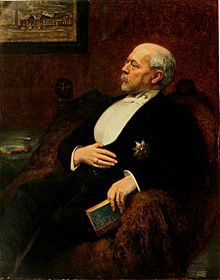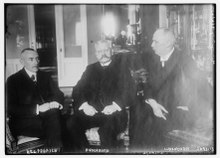Berlin Conference (November 2–6, 1917)
However, backed by the Reich, the Dual Monarchy was able to inflict an almost total defeat on the Italians on the Isonzo, while the tenacity of the German soldiers deprived the British, French and Belgians of a strategic victory in Flanders.
[8] Finally, Austro-Hungarian and German strategic planners prepared multiple offensives to be launched in France and Italy during the spring of 1918;[9] moreover, since October 26, German-Austro-Hungarian units have been engaged in the pursuit of the retreating Italian army on the Isonzo front.
[Note 3][10] On May 17, 1917, at the first official meeting between Wilhelm II and Charles I, a solution had been found to divide the continent into a German and an Austro-Hungarian sphere of influence, allocating Poland, Courland and Lithuania to the Reich and Romania, then occupied by the armies of the Quadruple Alliance, to the Dual Monarchy.
[13] On October 7, 1917, a conference held in Kreuznach, then headquarters of the Oberste Heeresleitung (OHL, German High Command), brought together Reich Chancellor Georg Michaelis and State Secretary Richard von Kühlmann, under the chairmanship of Wilhelm II.
[13] During this meeting, the military set out their objectives for the war after three years of conflict, in a 24-point memorandum;[14] they clashed with the civilians, firm supporters of the devolution of the Polish crown to a Habsburg archduke.
The Dioscuri aspired to place Austria-Hungary under the strict tutelage of the Reich for a period of twenty years, as part of a defensive and offensive military alliance, an extended customs union within the framework of the constitution of Mitteleuropa; furthermore, they wanted the Dual Monarchy to lose interest in Romania, in exchange for Poland.
[17] At the end of a heated exchange between civilians and the military, the Chancellor reached a compromise between the positions defended by the Dioscuri and those by the Secretary of State: the differences related more to the form that German preeminence in Europe should adopt than to its validity or geographical extension.
[15] After some political scheming, Hermann Johannes was replaced by his colleague, the diplomat Paul Koerner, who was fully committed to the Vice-Chancellor's economic plans and had a reputation for great skill in trade negotiations.
[21] The High Command and the government demanded guarantees which, in exchange for the evacuation of the country by German troops, called into question any real independence for the Belgian kingdom.
[27] On the eve of the October Revolution, the Reich's political and military leaders expanded the war aims they wished to see achieved for their country, even if this program appeared unrealistic at this stage of the conflict.
[16] However, this reinforcement, like the wide border strip promised to be annexed by the Reich, aroused the hostility of the Austro-Hungarian negotiators, who advocated a Polish state integrated into Austrian Galicia.
This categorical refusal enabled him to successfully defend the outcome of the previous spring's negotiations, under the terms of the joint German-Austro-Hungarian memorandum of June 18, 1917: Poland and the Baltic states remained assigned to the Reich, while Serbia, Montenegro, Albania and Romania belonged to the dual monarchy.






